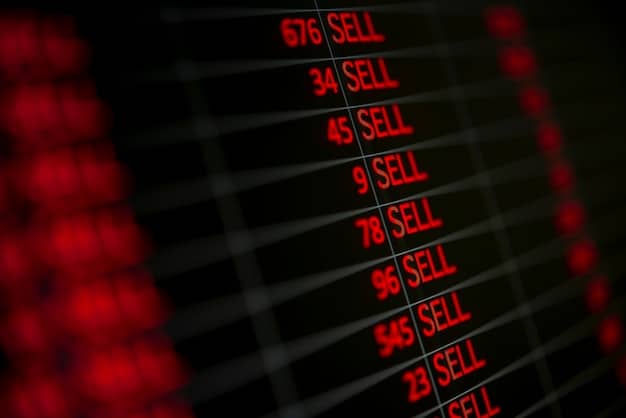Leverage SEC Regulations for Stock Buyback Returns in 2025

Leveraging the new SEC regulations on stock buybacks for higher returns in 2025 involves understanding the rule’s impact on market dynamics, identifying companies strategically using buybacks, and adjusting investment strategies to capitalize on potential price increases and enhanced shareholder value.
The Securities and Exchange Commission (SEC) has implemented new regulations regarding stock buybacks, which are poised to reshape investment strategies in 2025. Understanding these changes is crucial for investors aiming to enhance their returns. How to Leverage the New SEC Regulations on Stock Buybacks for Higher Returns in 2025 necessitates a strategic approach, and this article will guide you through the key aspects.
Understanding the New SEC Stock Buyback Regulations
The SEC’s new regulations on stock buybacks mark a significant shift in corporate financial practices. These rules aim to increase transparency and accountability, providing investors with more comprehensive information to make informed decisions. A key aspect of the regulations is the requirement for companies to disclose more details about their buyback programs.
Key Changes in SEC Regulations
The updated regulations mandate that companies disclose daily buyback activity, including the number of shares repurchased, the average price paid, and the purpose behind the buyback. This level of detail was previously unavailable, and it offers investors a more granular view of corporate buyback strategies. These changes aim to prevent insider trading and ensure fair market practices.
Impact on Market Transparency
With increased transparency, market participants can better assess the motivations and intentions behind stock buybacks. This enhanced visibility helps in evaluating whether buybacks are genuinely aimed at increasing shareholder value or simply manipulating stock prices. The new regulations allow investors to see if executives are timing buybacks to benefit from personal stock options or compensation packages.
- Daily disclosure requirements for buyback activity.
- Mandatory disclosure of the purpose behind buyback programs.
- Increased scrutiny of insider trading related to buybacks.
- Enhanced ability for investors to evaluate the true value of buybacks.
In summary, these regulatory changes are designed to create a level playing field, where investors have access to the same critical information as company insiders. This transparency is expected to foster more efficient and equitable market dynamics. By understanding these regulations investors can better position themselves to leverage them for higher returns in 2025.
Identifying Companies Likely to Benefit from Buybacks
Identifying companies that strategically utilize stock buybacks can be a lucrative approach for investors. These are typically companies with strong financial health, consistent cash flow, and a history of rewarding shareholders. However, the new regulations add another layer to consider– how well these companies adapt to the increased scrutiny and transparency.

Financial Health Indicators
Strong candidate companies usually have healthy balance sheets with low debt and ample cash reserves. Analyzing financial statements can reveal their capacity to sustain buyback programs without jeopardizing their long-term stability. Companies with a robust cash flow are more likely to continue buybacks even during economic downturns, making them reliable choices.
Historical Buyback Patterns
Examining a company’s historical buyback activity provides insights into their management’s approach to capital allocation. A consistent pattern of buybacks signals a commitment to returning value to shareholders. However, assess whether these historical patterns align with the new regulatory requirements and whether the company is adapting appropriately.
- Evaluate companies with robust cash flow and low debt.
- Analyze historical buyback patterns for consistency.
- Consider how companies adapt to the new SEC regulations.
- Look for commitment to rewarding shareholders through buybacks.
Identifying companies strategically benefiting from buybacks requires a thorough analysis of their financial health, historical patterns, and adaptability to new regulations. By focusing on these aspects, investors can pinpoint opportunities for higher returns in 2025. Understanding how companies navigate increased transparency is crucial.
Strategic Investment Approaches for Buyback Opportunities
Developing strategic investment approaches is essential to capitalize on stock buyback opportunities. There are several strategies investors can employ, from closely monitoring companies actively engaged in buybacks to using analytical tools to assess the impact on share prices. The key is to remain adaptable and informed.
Monitoring Active Buyback Programs
Keeping track of companies actively engaged in buyback programs allows investors to identify potential entry points. Regulatory filings provide real-time data on buyback activity, enabling investors to make timely decisions. This approach requires constant monitoring and swift action to capitalize on short-term price movements.
Analyzing the Impact on Share Prices
Buybacks typically reduce the number of outstanding shares, which can lead to increased earnings per share (EPS) and potentially boost the stock price. Analyzing the correlation between buyback announcements and subsequent price movements helps evaluate the effectiveness of this strategy. Also, consider external factors (e.g., market conditions) that might influence these patterns.

- Track companies actively engaged in buyback programs for timely decisions.
- Analyze the correlation between buybacks and share price increases.
- Use analytical tools to assess the impact of buybacks on EPS.
- Consider external market factors influencing buyback outcomes.
Employing strategic investment approaches, such as monitoring active buyback programs and analyzing their impact on share prices, can lead to better investment outcomes. Adapting to real-time data and external market factors ensures that investors are well-positioned to leverage buyback opportunities for higher returns in 2025. Being informed and proactive is key.
Risks and Challenges of Investing in Buyback Stocks
Investing in stocks of companies engaged in buybacks is not without risks and challenges. It’s essential to be aware of these pitfalls and to incorporate risk-management strategies into your investment approach. Understanding the downside is as crucial as identifying the potential upside.
Potential Overvaluation of Stocks
Stock buybacks can artificially inflate the price of a stock, leading to overvaluation. If a company uses buybacks to mask underlying financial weaknesses or declining revenues, the stock price may not be sustainable. Investors should carefully evaluate a company’s financial health beyond just its buyback activity.
Impact of Debt-Funded Buybacks
Companies that fund buybacks through debt may face financial strain if their performance deteriorates. High debt levels can limit their ability to invest in growth opportunities or weather economic downturns. It’s crucial to assess the source of funds for these buybacks and their potential long-term consequences.
- Recognize the potential for overvaluation due to buybacks.
- Evaluate the impact of debt-funded buybacks on financial stability.
- Consider alternative uses of capital that could drive growth.
- Understand the regulatory risks associated with buyback programs.
Being aware of the risks and challenges associated with investing in buyback stocks is crucial for making informed decisions. Understanding potential overvaluation, the impact of debt-funded buybacks, and regulatory issues can enhance your risk management approach and safeguard your investment portfolio.
Analyzing SEC Filings for Buyback Insights
Analyzing SEC filings is a vital skill for any investor looking to leverage stock buybacks. These filings provide detailed information about companies’ buyback programs, including the timing, volume, and purpose of the repurchases. Scrutinizing these documents can offer insights into management’s strategies and motivations.
Understanding SEC Form 10-Q and 10-K
SEC Form 10-Q (quarterly report) and 10-K (annual report) are crucial sources of information regarding buyback programs. These filings require companies to disclose significant details about their repurchase activities. Investors can find information on the numbers of shares repurchased and the prices paid.
Deciphering Form 8-K for Real-Time Updates
Form 8-K filings provide updates on major events, including announcements of new or modified buyback programs. This form allows investors to stay informed about changes in a company’s buyback strategy. Paying attention to these updates enables more timely investment decisions.
- Utilize SEC Form 10-Q and 10-K for buyback program details.
- Monitor Form 8-K for real-time announcements.
- Examine management’s explanations of buyback motivations.
- Verify the accuracy and completeness of reported data.
Analyzing SEC filings like Form 10-Q, 10-K, and 8-K is crucial for gathering in-depth understandings of buyback programs. By interpreting these documents meticulously, investors can gain crucial insights into companies’ strategies and make more informed investment decisions. Always verify the data and consider the management rationale.
Adjusting Your Portfolio for Optimal Buyback Returns in 2025
Adjusting your investment portfolio based on the new SEC regulations and their impact on stock buybacks requires a strategic and proactive approach. Rebalancing your portfolio to include companies that strategically use buybacks in a compliant manner can optimize your investment returns.
Diversification and Risk Management
Diversifying your portfolio across different sectors and companies reduces the risk associated with relying on a single buyback strategy. A well-diversified portfolio can cushion the impact of market volatility and ensure that you are not overly exposed to any particular stock or sector. Emphasize companies with solid fundamentals beyond just buybacks.
Long-Term vs. Short-Term Strategies
Depending on your investment goals, you can adopt a long-term or short-term approach to buyback stocks. Long-term investors may focus on companies with a history of consistent buybacks and sustainable financial health. Short-term investors might capitalize on the immediate market reaction to buyback announcements. Evaluate your goals to tailor your strategy.
- Diversify your portfolio to reduce risk and enhance returns.
- Establish a long-term or short-term investment approach.
- Rebalance your portfolio to capture sustained profits.
- Stay adaptable to take advantage of emergent buyback opportunities.
Adjusting your portfolio to include undervalued companies that also engage in strategic buybacks requires a thorough understanding of market dynamics and proactive management. Staying informed and adaptable to market changes will position you advantageously to leverage these opportunities for higher returns in 2025.
| Key Point | Brief Description |
|---|---|
| 📊 New SEC Regulations | Increased transparency and disclosure regarding buybacks. |
| 🔍 Finding Buyback Candidates | Look for strong financials, history of buybacks, and SEC compliance. |
| 📈 Investment Strategies | Monitor SEC filings, analyze share price impact, and diversify. |
| ⚠️ Risks to Consider | Overvaluation, debt-funded buybacks, and regulatory compliance issues. |
Frequently Asked Questions
▼
The new regulations require companies to provide more detailed and frequent disclosures about their buyback activities, including daily reporting of share repurchases and the rationale behind these actions.
▼
Investors should look for companies with strong financial health, consistent cash flow, a history of rewarding shareholders, and those that adapt well to the increased scrutiny from new regulations.
▼
Monitoring active buyback programs through regulatory filings (like Form 8-K) and analyzing the impact of buybacks on share prices, are key actions. Also being able to adapt to market conditions.
▼
Risks include potential overvaluation of stocks, especially if buybacks are used to mask underlying financial weaknesses, and financial strain from debt-funded buybacks reducing growth opportunities in those companies.
▼
Investors can analyze SEC filings such as Form 10-Q and 10-K for details about past buyback programs. Form 8-K provides real time updates on buyback program and helps with investment decisions throughout the year.
Conclusion
Navigating the landscape of stock buybacks under the new SEC regulations requires a blend of due diligence, strategic insight, and proactive portfolio management. By closely monitoring SEC filings to identify companies that strategically use buybacks, and understanding potential risks, investors can position themselves to achieve higher returns in 2025’s evolving market.





